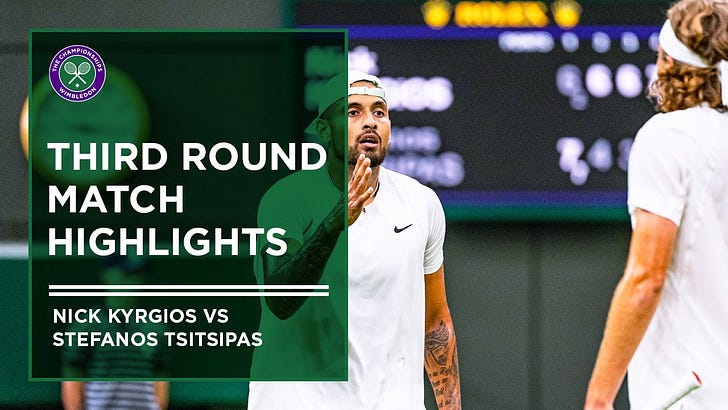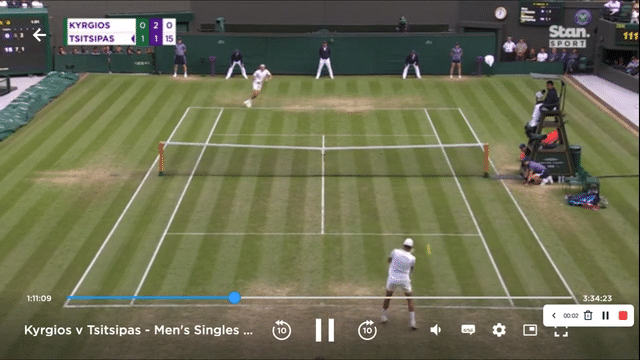Nick Kyrgios defeated Stefanos Tsitsipas 6/7 6/4 6/3 7/6 to progress to the fourth round and extend his H2H over the Greek to 4-1.
The pair met in Halle a fortnight ago, with Kyrgios coming through in a close three-set encounter I wrote about here. A takeaway from that piece (emphasis added):
On grass this is a terrible match-up for Tsitsipas; his weaker backhand defense (which I have touched on numerous times here and here) is magnified against such a big server on a quick surface. Tsitsipas’ slice backhand takeback is very short, leading to slices that both float long and dump in the net, especially when he is moving (such is the case when playing backhand defense). Technical limitations aside, the Greek came out with a clear game plan to chip returns in play and get into a lot of return points. The tactic almost paid off today, and it remains a key area for Tsitsipas to improve if he wants to climb higher.
Tsitsipas chipped a lot in the Halle match, and he had great success in doing so. If you stay disciplined and make as many returns in play as possible, you will get looks on Kyrgios’ serve; he can’t hurt you as much when the ball is low and skidding, especially from his backhand where he prefers to redirect pace with his bunt swing. Before the Wimbledon match, I tweeted what I thought were the keys for either guy:
Despite the clear signal from that Halle match, Tsitsipas went away from the slice and block return yesterday. Whether that was a deliberate adjustment or a lack of confidence with the slice I don’t know, but he only generated 5 break points in 4 sets and converted 0 for the match (by comparison, Tsitsipas generated 8 chances in their 3-set encounter. Six of those came in the first set, where Tsitsipas chipped >60% of returns). I didn’t track slice metrics from yesterday’s encounter, but my feeling is the same; when Tsitsipas was making a concerted effort to slice—whether defensively or offensively—Kyrgios looked far more uncomfortable; he was made to think, and Kyrgios excels at playing unconscious, instinctive tennis.
Not surprisingly, the first-serve for both was extremely effective, with both men winning ~80% of points. The difference was in the percentage of first-serves made: Kyrgios landed a whopping 71% whereas Tsitsipas was down at 59%. While Kyrgios ‘only’ hit 14 aces, a huge number of serves went unreturned, with Tsitsipas’ lack of an effective block either missing serves or floating back a cheap short ball.

Further analysis isn’t really warranted because most of this match was really about Kyrgios’ behaviour between the points. As I wrote after their Halle encounter:
We could talk about the serve, the hands, and the trick shots, but it would fail to accurately capture the player without talking about all the between-point antics. While someone like Bublik plays chaotic points, Kyrgios plays chaotic points and raises chaos between points as well—especially when losing. I don’t think it’s intentional as much as a habit: Kyrgios loses a point, gets emotional, looks to blame something—anything—other than himself, and the circus starts.
Yesterday was no different. Like a magician, Kyrgios distracts crowd and opponent with his mouth, then with sleight-of-hand pulls off parlor trick shots much to their delight (the former, only). However, the degree of abuse hurled at the umpire (and to his own box) went beyond what is ‘good for the game’. Kyrgios puts bums on seats for two reasons:
He is an immensely talented and creative tennis player; fans love the trick shots, the power slaps, and absurdly consistent clutch performances.
He smashes racquets, screams at his box, berates umpires, and tanks when losing.
The first reason can stand on its own; fans would still flock to watch a version of Kyrgios that quietly went about his craft with the odd cheeky crowd interaction. The same cannot be said for the latter. In a sense Kyrgios is an opportunist; much of the tennis rulebook occupies a grey area that Kyrgios plays on. Some examples from yesterday:
Starting second serves while ballboys were still on court running to the corners. The rule book states you must play to the server’s speed, but this borders on distracting for your opponent.
I’m not sure how many ‘fucks’ and ‘shits’ one can say before you get a code violation, but there is clearly no consistency to it.
Kyrgios challenged a Tsitsipas serve that was in by about a foot, clearly to disrupt the Greek’s rhythm in the fourth set.
Kyrgios called for Tsitsipas’ default after he hit a ball into the crowd in frustration.
None of this is black and white, and he is often right in pointing out the hypocrisy of some decisions based on rules that are unclear primarily because a player has never pushed the boundaries as much as Kyrgios, but his motivations for all of this—nearly every time—are simply because he is angry he is losing. He exposes the flimsiness of the rules, but that doesn’t mean that he isn’t an absolute pest in the wrong a lot of the time. The game seems to work fine without Kyrgios. The governing bodies need to either tighten their rulebook so as to bend Kyrgios’ behaviour, make it clearer there is a grey area at the umpire’s discretion, or get tougher when players question umpire decisions. Many other sports don’t allow any sort of talk back without some sort of penalty. Ultimately, this kind of match is not the best advertisement of the sport, and certainly falls short of the kind of drama we’ve been lucky to have over the past years with the Big-4 et al.
One of the commentators summed it up well:
“He’s got the talent of a grand slam champion buried beneath layers of anger and confused thinking, but he is an entertainer and a quite brilliant tennis player.”
Kyrgios plays Brandon Nakashima tomorrow for a place in the quarterfinals.






Nice summary of the Dark Lord Kyrgios. His tennis is often sublime, but his on court behaviour is often petulant.